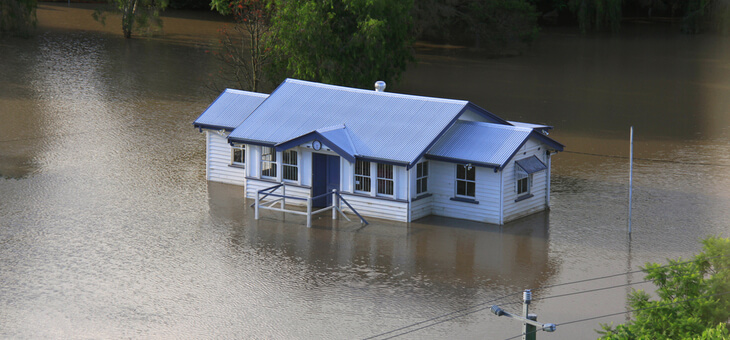Climate change is making natural disasters more common. Bushfires, tropical cyclones, floods and even earthquakes are occurring in Australia with increased regularity and severity. Here’s how to make sure your home is ready, just in case.
Insurance firm Suncorp has released the Resilient Home Report, a survey of 1195 Australians on how prepared their homes are for future natural disasters. The results show just a quarter of respondents had modified their homes in some way to protect against fire, flood or earthquake damage.
The company says Australia needs to address disaster mitigation, rather than just disaster clean-up and recovery, and that the nation needs to “build resilience”.
“Australia’s weather extremes are increasing in frequency and severity, and the financial and emotional impact on communities can be devastating and long-lasting,” Suncorp CEO Lisa Harrison says in the report.
Read: Renovations that offer bang for your buck
“Building resilience is not only about supporting customers and communities to get back on their feet when disaster strikes. It is about giving them the tools, knowledge, and support to proactively prepare and strengthen their homes, businesses and communities before an event hits.”
Identify your risks
The first step in preparing your home against natural disasters is to identify which threats are most likely in your location.
Tropical cyclones are a part of summer life in northern parts of Australia. According to the Bureau of Meteorology, Australia experiences an average of 10 cyclones per year and at least one tropical cyclone has made landfall each season since records began in the 1970s. The most cyclone-prone area in Australia is the northwest coast of WA between Broome and Exmouth, but anywhere above the 23 degree latitude line is potentially at risk.
Another part of summer life in Australia is bushfires. While they have always occurred, the intensity of bushfires is increasing, and the fire season is beginning earlier in the year and finishing later. All parts of the country are at risk from fire, but the most fire-prone is Victoria, where four out of the five most deadly bushfires have occurred.
According to another insurance firm, IAG, the most flood-prone areas in the country are all in Queensland and New South Wales. The Brisbane local government area, as well as Townsville, are listed as Queensland worst flood spots, while the Wollongong area is the most flood-prone in NSW.
Read: Increasing your Age Pension entitlements by renovating the family home
What can you do?
Fortunately, there are number of steps you can take to help prepare your home for these threats.
There are various products on the market protect against cyclones. One of the simplest is the cyclone washer, a reinforced washer designed to withstand extreme winds. Replace existing washers around the house with their cyclone-proof variants for extra protection.
Protecting against a tropical cyclone mostly involves armouring your house. Metal gutter guards, shutters and window frames are also available in cyclone-proof specifications.
Bushfires can spring up at a moment’s notice in summer, so it’s important to prepare your house well ahead of bushfire season. Embers landing in roof gutters are a major threat, so making sure they are clear of any leaves and debris is essential. Even better is installing a gutter guard such as the Leaf Stopper, which diverts this potential fire fuel away from your home.
Read: Natural disasters and your home insurance explained
If you live in a particularly fire-prone area you may even want to consider sealing your roof cavity with fire-proof insulation.
Guarding your home against the threat of flood may be the most difficult. By far, the best protection against flood is to live on elevated land away from rivers. It’s true that preparing your home for a flood involves having items on hand to deal with flood conditions.
If you’re already living in these low-lying areas there are options. Permanent flood gates can be installed around your home or property and temporary inflatable flood barriers to keep in the garage can be a literal life saver in flood conditions.
And if the worst does happen, there are a number of alternatives to the sandbags you can keep on hand should the need arise.
Have you made any modifications to you house to protect against natural disasters? Are you worried about any potential threats in future? Let us know in the comments section below.
If you enjoy our content, don’t keep it to yourself. Share our free eNews with your friends and encourage them to sign up.

